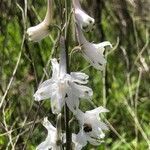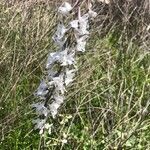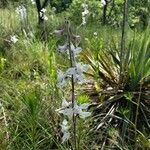Stem 5–10(–15) dm, pubescent throughout, glandular above; lvs well distributed along the stem, deeply dissected into linear segments seldom over 2 mm wide, the upper petioles notably short or wanting; basal lvs soon deciduous, mostly wanting at anthesis; racemes elongate, often branched, virgate, the lower pedicels to 2 cm; fls mostly blue (except for the usually white upper pet), rarely white; spur 13–18 mm; lower pet bifid, bearded; follicles 10–15+ mm; seeds obscurely 3-winged, the sides covered with appressed scales; 2n=16 (32). Dry woods, prairies, and sand-hills; n. Fla. to e. Tex., n. to N.C., Ky., Ill., Io., and w. Kans. May–July. (D. azureum; D. nortonianum)



